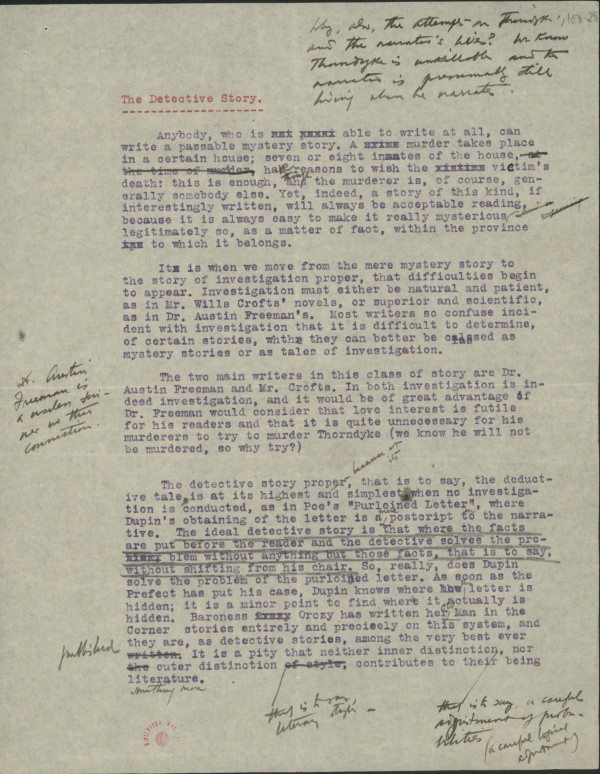Identificação
[BNP/E3, 100 – 29]
The Detective Story.
Anybody, who is able to write at all, can write a passable mystery story. A murder takes place in a certain house; seven or eight inmates of the house, have reasons to whish the victim’s death: this is enough, and[1] the murderer is, of course, generally somebody else. Yet, indeed, a story of this kind, if interestingly written, will always be acceptable reading, because it is always easy to make it really mysterious – legitimately so, as a matter of fact, within the province to which it belongs.
It is when we move from the mere mystery story to the story of investigation proper, that difficulties begin to appear. Investigation must either be natural and patient, as in Mr. Wills Crofts’ novels, or superior and scientific, as in Dr. Austin Freeman’s. Most writers so confuse incident with investigation that it is difficult to determine, of certain stories, whether they can better be classed as mystery stories or as tales of investigation.
The two main writers in this class of story are Dr. Austin Freeman and Mr. Crofts. In both investigation is indeed investigation, and it would be of great advantage if Dr. Freeman would consider that love interest is futile for his readers and that it is quite unnecessary for his murderers to try to murder Thorndyke (we know he will not be murdered, so why try?) {…} Dr. Austin Freeman is a useless sinner in this connection. Why, also, the attempts on Thorndyke’s and the narrator’s lives? We know Thorndyke is unkillable and the narrator is presumably still living when he narrates.
The detective story proper, that is to say, the deductive tale, is at its highest and[2] simplest when no investigation is conducted, as in Poe’s “Purloined Letter”, where Dupin’s obtaining of the letter is a mere postscript to[3] the narrative. The ideal detective story is that where the facts are put before the reader and the detective solves the problem without anything but those facts, that is to say, without shifting his chair. So, really, does Dupin solve the problem of the purloined letter. As soon as the Perfect has put his case, Dupin knows where the letter is hidden; it is a minor point to find where it actually is hidden. Baroness Orczy has written her Old Man in the Corner stories entirely and precisely on this system, and they are, as detective stories, among the very best ever published. It is a pity that neither inner distinction, that is to say, a careful adjustment of probabilities[4], nor outer distinction, that is to say, literary style –, contributes to their being literature[5].
[BNP/E3, 100 – 29]
A História Policial.
Alguém que seja capaz de escrever consegue escrever uma história de mistério aceitável. Um assassinato ocorre numa certa casa; sete ou oito habitantes da casa têm razões para desejar a morte da vítima: isto é suficiente e o assassino é, com certeza, geralmente outra pessoa. Contudo, é certo que uma história deste tipo, se escrita de uma forma interessante, será sempre uma leitura aceitável. Porque é sempre fácil torná-la realmente misteriosa – sendo isso legítimo, de facto, dentro da esfera a que pertence.
É quando nos passamos da mera história de mistério para a história de investigação propriamente dita que começam a aparecer as dificuldades. A investigação deve ser ou natural e paciente, como nos romances do Sr. Wills Crofts, ou superior e científica, como no Dr. Austin Freeman. A maioria dos escritores confunde assim incidentes com investigação de forma que é difícil determinar se certas histórias se podem ser melhor classificadas como histórias de mistérios ou histórias de investigação.
Os dois escritores principais nesta classe de histórias são o Dr. Austin Freeman e o Sr. Crofts. Em ambos a investigação é efectivamente investigação e seria uma grande vantagem se o Dr. Freeman considerasse que o interesse amoroso é inútil para os seus leitores e que é muito desnecessário para os seus assassinos tentar assassinar Thorndyke (sabemos que ele não será assassinado, então porque tentar?) {…} O Dr. Austin Freeman comete um pecado inútil a este respeito. Porquê também os atentados às vidas de Thorndyke e do narrador? Sabemos que Thorndyke não pode ser morto e que o narrador se encontra ainda vivo quando narra.
A história policial propriamente dita, isto é, a história dedutiva, encontra-se no seu ponto mais alto e mais simples quando não existe nenhuma investigação, como em “Purloined Letter” de Poe, onde a obtenção da carta por Dupin é um mero pós-escrito à narrativa. A história policial ideal é aquela em que os factos são postos diante do leitor e o detective resolve o problema sem nada mais do que esses factos, isto é, sem sair da sua cadeira. Desse modo, Dupin resolve realmente o problema da carta roubada. Assim que o perfeito apresenta o seu caso, Dupin sabe onde a carta se encontra escondida; é uma questão de pouca importância encontrar onde ela se encontra de facto escondida. A Baronesa de Orczy escreveu as histórias de Old Man in the Corner completa e precisamente de acordo com este sistema e elas encontram-se, enquanto histórias policiais, entre as melhores que já foram publicadas. É uma pena que nem a distinção interior, isto é, um ajustamento cuidadoso de probabilidades, nem a distinção exterior, isto é, o estilo literário –, contribua para elas serem literatura.
[1] and /though\
[2] and /because at its\
[3] to /in\
[4] a careful adjustment of probabilities /(a careful logical adjustment)\
[5] literature /something more\
Classificação
Dados Físicos
Dados de produção
Dados de conservação
Palavras chave
Documentação Associada
Publicação integral: Fernando Pessoa, Histórias de um Raciocinador e o Ensaio «História Policial», edição e tradução de Ana Maria Freitas, Lisboa, Assírio & Alvim, 2012, pp. 238-239.


